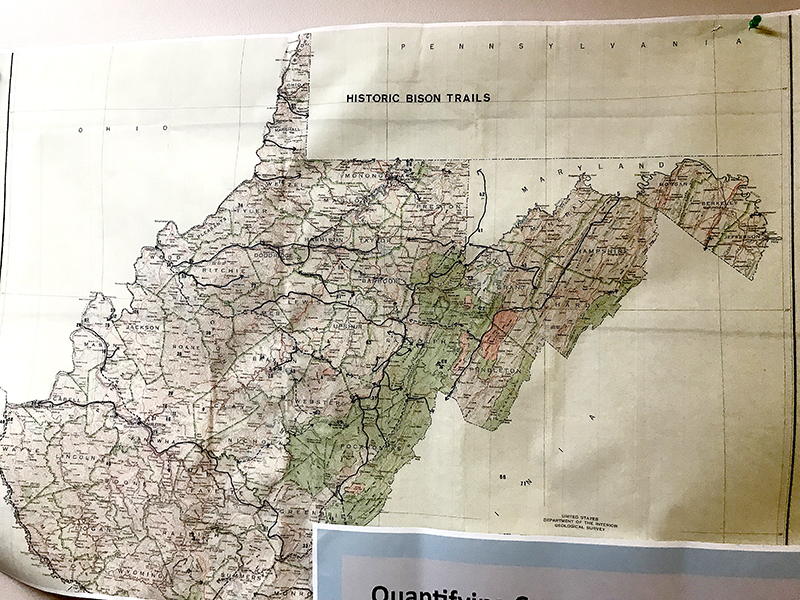
By Heather Clower
The Parsons Advocate
Trifolium stoloniferum, or more commonly known as Running Buffalo Clover, is a perennial clover that is native to the eastern and Midwestern portions of the United States. Up until 1983, when it was rediscovered in Webster County by Rodney Bartgis, it was thought to have been extinct. Fast forward to 1987, the Fish and Wildlife Service proposed this variety of clover be listed as an endangered species. Six years later, in 1993, it was found on the Fernow Experimental Forest.

The late Clay Smith was project leader of a Timber group when this plant was discovered in one of his experimental logging sites. Melissa Thomas-Van Gundy, a research forester with the forest service stationed in what we know as The Nursery Bottom, stated this discovery lead to a moment of panic for Smith and his team as this meant he had to stop his project. The group worked closely with the Fish and Wildlife Service to rebuild the skid road to continue production, avoiding the location the clover was discovered to keep moving forward in their process. Van Gundy laughed as she noted the area that the crews were then avoiding to preserve this endangered plant deteriorated and began sprouting where they rebuilt the new skid road.
She took a moment to explain how this variety of clover is constructed, saying, “The stolen is a stem that pops up through the ground and then little roots begin to spout off.” This makes a “running” effect for how these plants spread and sprout. “It has been proposed for delisting from the endangered species list,” she informed as she showed a map of how it was thought these plants came here.
The map indicated proposed routes bison took as they once travelled across our state. This clover tends to run along those same routes where the herds made a disturbance in the soil on their pathways. It is also believed that the areas where the Running Buffalo Clover is more in a patch versus along a pathway that this may have been a bedding area or a location the buffalo used for a dirt bath. Van Gundy explained that this plant needs a disturbance in the soil to migrate and reproduce. Buffalo trails, skid roads, and similar areas make for ideal habitat for repopulation. “We know the skidder moved some,” she said as they knew they drove over the plant, then redirected their road to a location without any clover just to find it reappears in the new skid road once work was complete. Another note mentioned was that deer and other herbivore wildlife eating the plant and passing the seeds do not seem to repopulate this plant, it requires physical movement.
Much research has commenced on this clover variety to determine what growing habitats it prefers and which it does not. Lighting conditions is an area still being investigated, but it’s very evident it prefers a disturbed location as well as nitrogen rich soils due to its inability to make its own. They are very fond of limestone as well and prefer a partial harvest versus a clear cut when considering logging sites. Another study conducted was the timeframe in which it returns once being disturbed and redistributed, be it through the hooves of buffalo or on the tracks of a skidder. The magic timeframe for peak performance of the Running Buffalo Clover is between eight and fourteen years later when observed on the Fernow. Van Gundy elaborated that any time after that fourteen year mark the clover tends to be overtaken by other vegetation in the area.
Van Gundy is a part of the recovery team that was a part of working towards reestablishing this plant in enough quantities to remove it from the list. Enough research has allowed this team, in collaboration with the West Virginia Division of Natural Resources, US Fish and Wildlife Services, and various university partners throughout time, to present enough facts to show those goals have been met. “Every species (on the list) has a recovery plan,” she explained. These plans are worked towards by several entities to assist repopulation of other rare plants that once inhabited our region. Now that the facts have been presented, it has been posted on the federal register to allow public comments regarding the proposal of removing from the endangered species list. “It’s a 60 days notice,” she said, with the deadline being October 28 to submit public comment. Once the timeframe lapses, the results will be reviewed by a panel of experts to make the final decision. If successfully removed, the recovery team transitions to a management team to continue observing these plants and assist in proper management to ensure they do not return to that list.
While there were many parts to the grand result of the potential of removing this plant from the endangered species list over the last few decades, there is one common scheme to thank for this potential result. If it hadn’t been for the long term research going on at the Fernow, there would not be enough data to support this proposal. If you are interested in learning more about the experimental forest or Running Buffalo Clover, stop by the station in the Nursery Bottom and talk to any of the park rangers. If you would like to read the public comments or make one on your own behalf, you can visit www.federalregister.gov and type in Running Buffalo Clover in the search bar.



